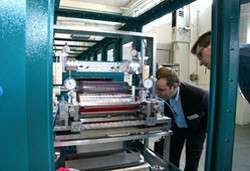Smart windows with electrochromic film—almost ready for prime time

EC film devices have been hampered in making the move from research to innovation by a number of technical and economic obstacles. EELICON aims to overcome these obstacles by removing equipment limitations, automating processes, and validating a possible high-throughput prototype production process for a cost-effective, high-performance EC film technology.
Retrofitting windows with an electrically dimmable plastic film is a dream that is finally coming close to fruition. According to life cycle assessment studies, considerable energy savings may result when such films are included in architectural glazing, appliance doors, aircraft cabin windows, and vehicle sunroofs; and user comfort is enhanced as well.
The EU-funded EELICON (Enhanced Energy Efficiency and Comfort by Smart Light Transmittance Control) project is focusing on an innovative switchable light transmittance technology that was developed in a project previously co-funded by the EU Framework Programmes. The project developed mechanically flexible and light-weight electrochromic (EC) film devices based on a conductive polymer nanocomposite technology with a property profile far beyond the current state-of-the art.
Dr. Uwe Posset, project coordinator and Expert Group Manager at ZfAE - Center for Applied Electrochemistry, Fraunhofer ISC, discusses the project's achievements so far.
Do you have any results to show regarding the objectives that you have defined?
We are indeed working on a demonstration line to roll out a possible production process for electrochromic (EC) films, i.e. plastic films that can change colour upon application of a small voltage. Such films can be used to create smart windows for the control of sunlight and glare in buildings and vehicles. This technology is known to have the potential to save substantial amounts of energy for air conditioning. Darkening the film will decrease heat gain in the interior while maintaining the view through the window. The film provides possibilities to retrofit existing windows.
Do you have results from a life cycle assessment (LCA)?
Yes. The results essentially show that the targeted film technology can be produced with less primary energy than a standard EC window. We are currently working on extending the LCA to demonstrate the energy saving potential of the EC film during the use phase.
How much do you expect the technology to cost? How competitive will it be with existing technologies (e.g. price/performance)?
We target a price level of 200 €/m2, which is about a factor of 4 less than standard EC windows based on glass. To be really competitive, an even lower price may be required, but 200 €/m2 is usually discussed in the community as a threshold price for competitiveness. A full performance evaluation is currently in progress. According to discussions with potential end-users, producers and customers, price is the major driver, while some performance aspects may be negotiable, depending on the application.
How easy or difficult will the technology be to commercialise?
It is a complex process presumably requiring an industrial development phase of 2-3 years after the end of the project and substantial investment (currently estimated: €10 million).
Which are the most promising application areas?
Smart windows for energy-efficient buildings, vehicle sunroofs, smart aircraft cabin windows, switchable appliance doors, smart eyewear and visors.
What are the main benefits provided by the technology (any quantitative data would be welcome in addition to a qualitative description)?
There are many benefits. What we are developing is a film-based technology suitable for window integration and retrofitting. It will have short switching times (<1 min as compared to 10-15 min for state-of-the-art EC windows), and most importantly cost-effective, high-throughput production will be possible (roll-to-roll manufacturing).
Our technology will also have a higher bleached state visual light transmittance as compared to state-of-the-art EC windows (60-65 % vs. 50-55 %); a lower darkened state visual light transmittance as compared to state-of-the-art EC windows (5-10 % vs. 10-15 %); it will be fully colourless ("neutral tint") bleached state with no residual colour or hue.; it will have an appreciable g-value modulation as opposed to liquid crystal-based smart window film technologies; it is mechanically rugged; and it has a large thermal operation range (-25 to +60 °C).
Once the project is completed, what will be the next steps? How do you see the technology evolving in the future?
We will then have to focus on industrial development – scaling from pilot to production scale. Huge markets will become accessible in the future if the price target can be met and minimum performance requirements are fulfilled.
Provided by CORDIS




















